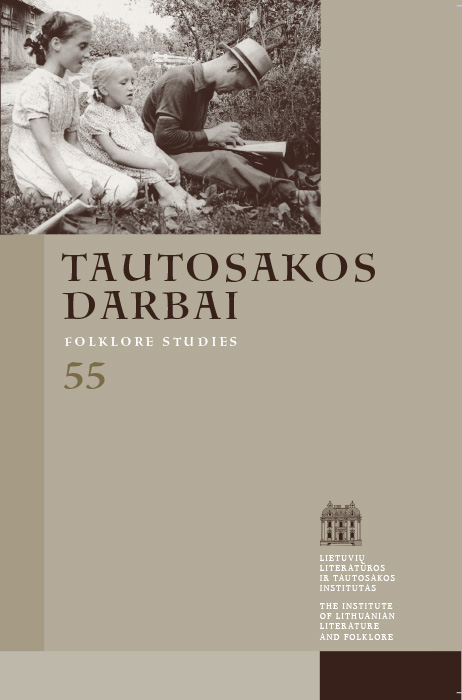Personal Collections of Texts from the Second Half of the 19th Century along with Their Historical Context
Abstract
The subject of the article comprises Lithuanian collections of texts from the second half of the 19th century, compiled by individuals of peasant origins and preserved at the Lithuanian Folklore Archives. The research involves over 40 of such collections, in which part or majority of the inscriptions consist of poetic pieces: personal poetic compositions or folksongs chiefly selected from printed sources of the time. The analysis in the article focuses on the contents of these texts, describing various components of their repertoire, attempting at establishing and identifying the sources, from which the individual texts could have originated. Analysis of these collections takes into account the social and cultural context in Lithuania of the 19th century, chiefly defined by the imperial policy of the tsarist Russia, essentially aiming at strengthening the loyalty of the Lithuanian population to the official government, and the movement of national revival, striving to enhance the Lithuanian national self-consciousness. The author assumes the main motive behind the compilation of the personal collections of texts to be the issue of problematic availability of the Lithuanian press, partly caused by the four decades-long ban of printing in Latin alphabet, which had fatal harmful consequences to the development of the Lithuanian national culture. The author of the article concludes that majority of the collections in question probably comprised texts published by the illegal Lithuanian press of the time: newspapers, calendars, books of religious literature or popular fiction, folklore publications, or manuscripts by other people. However, the possibility of some texts finding their way into these collections directly from oral tradition is also valid. Analysis of the poetic repertoire of the personal collections enables asserting that their compilers / owners equally appreciated rather diverse written pieces – both literary compositions (mainly individual poetry) and folksongs. Such stratification of individual poetry and traditional songs derived from the interest in Lithuanian folklore, which was particularly characteristic to the culture of the national revival, and from the fact that in publications of the second half of the 19th century both individual poems and folksongs appeared as poetic compositions of the same nature.
According to the scarce personal data occurring in the manuscripts and mostly representing provenance, the author of the article attempts drawing a broad-brush portrait of the compiler of the textual collection. This must have been a rather young male of peasant origins, who has graduated from primary school (either illegal or official one) and attended gymnasium or seminary; literate in Lithuanian, Polish and Russian; open to the ideas of the national revival and interested in the available written sources of religious or secular kind.
The manuscripts compiled for individual purposes discussed in this article emerge as an important source for the analysis of relationship between individual creativity and writing in general with folklore. The Lithuanian collections of texts from the second half of the 19th century have captured a moment in the confluence of written and oral tradition, which rather than being identified with merging of these cultural systems should be perceived as a certain stage of adapting individual literary creativity to the folklore communication. We should regard these compilations of textual materials as belonging to the written culture rather than folklore as oral tradition.
The author also investigates the issue of traditionalism, of historical continuity in relation to these collections of texts picked out and copied from miscellaneous sources. The Lithuanian personal collections of texts from the second half of the 19th century functioning in the peasant society should be related to the earlier traditional collections of texts in Latin, Polish, and old Slavonic languages from the 17th – beginning of the 19th century Lithuania. The Lithuanian data thus becomes part of the wider European historical and cultural context. Personal collections of texts as a rather peculiar genre relate to the commonplace books thriving in the Renaissance period, which served in the humanist educational system as means for disciplined reading. The article presents a retrospective survey of subsequent changes in content and form experienced by these extract books / collections of texts on their way from the academic discourse to the private everyday sphere.
Downloads
Most read articles by the same author(s)
- Jurgita Ūsaitytė, Song as a Propaganda Tool: Surveying the Soviet Time Songbooks , Tautosakos darbai: Vol. 65 (2023): Tautosakos darbai
- Vita Džekčioriūtė, Aušra Žičkienė, Jūratė Šlekonytė, Gražina Kadžytė, Jurgita Ūsaitytė, Lina Būgienė, Daiva Vyčinienė, Chronicle , Tautosakos darbai: Vol. 48 (2014)
- Jurgita Ūsaitytė, Reception of Folksongs in the Lithuanian Press of the National Revival , Tautosakos darbai: Vol. 58 (2019)
- Audronė Gedžiūtė, Jūratė Šlekonytė, Jurgita Ūsaitytė, Vita Ivanauskaitė-Šeibutienė, Chronicle , Tautosakos darbai: Vol. 57 (2019)
- Jurgita Ūsaitytė, The News in Album Studies (Two Case Reviews) , Tautosakos darbai: Vol. 52 (2016)
- Jurgita Ūsaitytė, Songbooks as a Mode of Personal Notes , Tautosakos darbai: Vol. 50 (2015)
- Jurgita Ūsaitytė, Foreword , Tautosakos darbai: Vol. 48 (2014)
- Jurgita Ūsaitytė, Foreword , Tautosakos darbai: Vol. 63 (2022)
- Jurgita Ūsaitytė, Foreword , Tautosakos darbai: Vol. 59 (2020)




